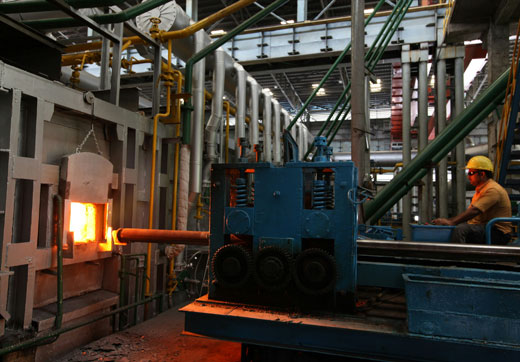
Graphite Coatings: Benefits and Industrial Uses
When equipment operates in extreme environments—high temperatures, corrosive conditions, or situations requiring low friction and dry lubrication—traditional protective coatings often fail. And let’s be honest--what industrial equipment doesn’t operate in an extreme environment? It is in such environments that graphite coating technology proves invaluable. Graphite offers unique properties like dry lubrication and corrosive resistance that make it a favored material in numerous industrial applications. For many of these applications, synthetic graphite components are standard. However, graphite coatings are sometimes used on other materials, from steel to plastics, to enhance the performance or durability of the underlying material. Below, we’ll take you through the unsung but significant application of graphite coatings.
What Are Graphite Coatings?
Graphite coatings consist of thin films or layers of graphite applied to surfaces to enhance performance in demanding environments. Now, if you’re thinking about coatings you apply to yourself in demanding environments, like sunscreen on a sunny day at the beach, you would not be far off. In the case of graphite coatings, they can be water-based or solvent-based, depending on the application requirements, and are typically applied through spraying, brushing, or dipping processes (this last method is where our sunscreen analogy breaks down).
Key Benefits of Graphite Coatings
High-Temperature Lubrication represents perhaps the most significant advantage of graphite coatings. Unlike conventional lubricants that break down under extreme heat, graphite coatings maintain their protective properties even at temperatures where oils and greases would completely fail. We’re talking environments that far surpass your car engine, where the operating temperature just north of 200℉ are not hot enough to break down motor oil, which holds its integrity up to 250℉ (or around 300℉ for synthetic oil). Graphite coatings, on the other hand, remain stable at temperatures well over 5000℉. Graphite is thus essential for applications involving furnaces, engines, and high-temperature manufacturing processes.
Low Friction properties of graphite reduce wear and extend the lifespan of moving parts. The natural lubricity of graphite creates a slippery surface that minimizes metal-to-metal contact, reducing energy consumption and maintenance requirements in mechanical systems.
The Corrosion Resistance of graphite provides a protective barrier against oxidation, moisture, and chemical exposure. This makes graphite coatings particularly valuable in harsh chemical environments or outdoor applications where traditional protective coatings might deteriorate.
Electrical Conductivity makes graphite coatings useful for applications requiring static dissipation or electromagnetic interference (EMI) shielding. This property proves useful in electronics manufacturing and sensitive equipment applications.
Thermal Conductivity helps manage heat distribution in high-performance systems. The coating can help dissipate heat more effectively, preventing hot spots that could damage sensitive components.
Common Industrial Uses
Many industries take advantage of two or more of these benefits of graphite coatings at once. Here are three notable examples of industries that rely on the multifaceted strengths of graphite.
Aerospace applications represent one of the most demanding uses for graphite coatings. Jet engine components, turbine blades, and exhaust systems must withstand extreme temperatures while maintaining precise tolerances. Graphite coatings provide the dry lubrication and thermal protection these components require to function reliably in such harsh conditions.
Automotive industries utilize graphite coatings in brake linings, gaskets, and engine parts where heat and friction management are critical. The coatings help components perform consistently under the high-temperature, high-stress conditions common in automotive applications.
Metallurgy operations rely heavily on graphite coatings for lubricating dies and molds in forging, casting, and extrusion processes. The coatings prevent metal from sticking to tooling surfaces while providing the high-temperature protection needed during metal forming operations.
Application Considerations
At Semco Carbon, we understand the importance of surface treatments in high-performance applications. While we specialize in precision graphite machining rather than coating application, we recognize how coatings can enhance the performance of graphite components. Our experience with diffusion barrier coatings for graphite fixtures demonstrates how specialized surface treatments can extend component life and improve performance in demanding applications.
As always, if you have questions about how graphite applications, including graphite coatings, can benefit your manufacturing or industrial processes, reach out to the graphite experts at Semco Carbon for a consultation.
